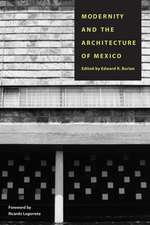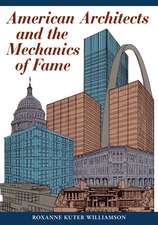Sanctioning Modernism: Architecture and the Making of Postwar Identities
Editat de Vladimir Kulic, Timothy Parker, Monica Penick Introducere de Frederick Steineren Limba Engleză Paperback – iun 2014
In the decades following World War II, modern architecture spread around the globe alongside increased modernization, urbanization, and postwar reconstruction—and it eventually won widespread acceptance. But as the limitations of conventional conceptions of modernism became apparent, modern architecture has come under increasing criticism. In this collection of essays, experienced and emerging scholars take a fresh look at postwar modern architecture by asking what it meant to be “modern,” what role modern architecture played in constructing modern identities, and who sanctioned (or was sanctioned by) modernism in architecture.
This volume presents focused case studies of modern architecture in three realms—political, religious, and domestic—that address our very essence as human beings. Several essays explore developments in Czechoslovakia, Romania, and Yugoslavia and document a modernist design culture that crossed political barriers, such as the Iron Curtain, more readily than previously imagined. Other essays investigate various efforts to reconcile the concerns of modernist architects with the traditions of the Roman Catholic Church and other Christian institutions. And a final group of essays looks at postwar homebuilding in the United States and demonstrates how malleable and contested the image of the American home was in the mid-twentieth century. These inquiries show the limits of canonical views of modern architecture and reveal instead how civic institutions, ecclesiastical traditions, individual consumers, and others sought to sanction the forms and ideas of modern architecture in the service of their respective claims or desires to be modern.
Preț: 317.48 lei
Nou
Puncte Express: 476
Preț estimativ în valută:
60.75€ • 63.60$ • 50.27£
60.75€ • 63.60$ • 50.27£
Carte tipărită la comandă
Livrare economică 05-19 aprilie
Preluare comenzi: 021 569.72.76
Specificații
ISBN-13: 9781477307595
ISBN-10: 1477307591
Pagini: 304
Ilustrații: 55 b&w photos, 35 b&w illus.
Dimensiuni: 178 x 254 x 23 mm
Greutate: 0.54 kg
Editura: University of Texas Press
Colecția University of Texas Press
ISBN-10: 1477307591
Pagini: 304
Ilustrații: 55 b&w photos, 35 b&w illus.
Dimensiuni: 178 x 254 x 23 mm
Greutate: 0.54 kg
Editura: University of Texas Press
Colecția University of Texas Press
Notă biografică
Vladimir Kulic is Assistant Professor in the School of Architecture at Florida Atlantic University in Fort Lauderdale. He is the coauthor of Modernism In-Between: The Mediatory Architectures of Socialist Yugoslavia and the coeditor of Unfinished Modernizations—Between Utopia and Pragmatism: Architecture and Urban Planning in the Former Yugoslavia and the Successor States.
Timothy Parker is Assistant Professor in the School of Architecture and Art at Norwich University in Northfield, Vermont.
Monica Penick is Assistant Professor in Design Studies at the University of Wisconsin–Madison.
Timothy Parker is Assistant Professor in the School of Architecture and Art at Norwich University in Northfield, Vermont.
Monica Penick is Assistant Professor in Design Studies at the University of Wisconsin–Madison.
Cuprins
Foreword
Frederick Steiner
Preface
Vladimir Kulić, Timothy Parker, and Monica Penick
Acknowledgments
Introduction. Writing History: Reflections on the Story of Midcentury Modern Architecture
Dennis P. Doordan
Part I. Modernism and the State
Introduction
Vladimir Kulić
1. Bucharest: The City Transfigured
Juliana Maxim
2. The Scope of Socialist Modernism: Architecture and State Representation in Postwar Yugoslavia
Vladimir Kulić
3. Czechoslovakia's Model Housing Developments: Modern Architecture for the Socialist Future
Kimberly Elman Zarecor
4. Sanctioning Modernism and Tradition: Italian Architecture, the Vernacular, and the State
Michelangelo Sabatino
Part II. Making Religion Modern
Introduction
Timothy Parker
5. Uncertainty and the Modern Church: Two Roman Catholic Cathedrals in Britain
Robert Proctor
6. "Humanly sublime tensions": Luigi Moretti's Chiesa del Concilio (1965–1970)
Timothy Parker
7. Modernism and the Concept of Reform: Liturgy and Liturgical Architecture
Richard Kieckhefer
Part III: Modernism and Domesticity
Introduction
Monica Penick
8. "Technologically" Modern: The Prefabricated House and the Wartime Experience of Skidmore, Owings and Merrill
Hyun-Tae Jung
9. "Modern but not too modern": House Beautiful and the American Style
Monica Penick
10. House and Haunted Garden
Sandy Isenstadt
Further Reading
Frederick Steiner
Preface
Vladimir Kulić, Timothy Parker, and Monica Penick
Acknowledgments
Introduction. Writing History: Reflections on the Story of Midcentury Modern Architecture
Dennis P. Doordan
Part I. Modernism and the State
Introduction
Vladimir Kulić
1. Bucharest: The City Transfigured
Juliana Maxim
2. The Scope of Socialist Modernism: Architecture and State Representation in Postwar Yugoslavia
Vladimir Kulić
3. Czechoslovakia's Model Housing Developments: Modern Architecture for the Socialist Future
Kimberly Elman Zarecor
4. Sanctioning Modernism and Tradition: Italian Architecture, the Vernacular, and the State
Michelangelo Sabatino
Part II. Making Religion Modern
Introduction
Timothy Parker
5. Uncertainty and the Modern Church: Two Roman Catholic Cathedrals in Britain
Robert Proctor
6. "Humanly sublime tensions": Luigi Moretti's Chiesa del Concilio (1965–1970)
Timothy Parker
7. Modernism and the Concept of Reform: Liturgy and Liturgical Architecture
Richard Kieckhefer
Part III: Modernism and Domesticity
Introduction
Monica Penick
8. "Technologically" Modern: The Prefabricated House and the Wartime Experience of Skidmore, Owings and Merrill
Hyun-Tae Jung
9. "Modern but not too modern": House Beautiful and the American Style
Monica Penick
10. House and Haunted Garden
Sandy Isenstadt
Further Reading
Descriere
With new research on building programs in political, religious, and domestic settings in the United States and Europe, this collection of essays offers a fresh look at postwar modernism and the role that architecture played in constructing modern identiti










